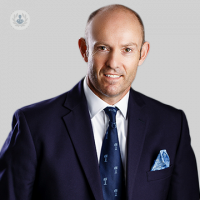An expert's guide to shoulder arthritis: part 2
Escrito por:In the second article of a two-part series, distinguished consultant orthopaedic surgeon Mr Graham Tytherleigh-Strong explains the various surgical options for the treatment of shoulder arthritis.

Keyhole surgery for shoulder arthritis
Shoulder arthritis, is a ‘wear and tear’ condition. The future approach involves preventing or detecting it early on, potentially through stem cell treatment for regenerating articular cartilage. While there are existing treatments for cartilage repair, they are typically effective only in the earliest stages or for isolated damage, making them less applicable when symptoms of shoulder arthritis manifest. In practical terms, by the time symptoms arise, the wear and tear have often progressed beyond the point where current regenerative treatments can be beneficial.
Surgery for shoulder arthritis focuses on improving joint surfaces by addressing issues such as loose fragments, soft tissue contractures, or resorting to shoulder replacement. However, it's important to note that surgery cannot reverse the effects of arthritis completely, and an arthritic shoulder cannot be transformed into a healthy, youthful one.
Additionally, the degeneration of soft-tissue structures, especially the rotator cuff tendons, is a significant factor in shoulder arthritis. Many patients with shoulder arthritis also experience rotator cuff problems, emphasising the need to consider these issues for a comprehensive and successful treatment approach.
Arthroscopic surgery (keyhole) for shoulder arthritis
Arthroscopic surgery for shoulder arthritis is a temporary solution designed to clean and improve the joint by removing damaged fragments, addressing soft-tissue contractures, and dealing with rotator cuff issues. The procedure offers the advantage of being a day-case surgery with no need for post-operative immobilisation and a quick recovery.
However, it doesn't address the underlying 'wear and tear' of the joint, focusing more on providing pain relief rather than significantly improving the range of motion. Importantly, arthroscopic surgery is a minimal procedure that doesn't hinder future shoulder replacement, and it can offer effective pain relief, especially for patients with advanced arthritis who may not be suitable for or prefer to avoid joint replacement due to medical reasons.
Arthroscopic debridement of the shoulder
The recommended procedure for individuals experiencing early and treatment-resistant shoulder arthritis is an arthroscopic debridement of the shoulder. This involves using an arthroscopic camera and specialised instruments to remove loose fragments, smooth the joint surface, and release any soft-tissue contractures. In cases with associated rotator cuff issues such as supraspinatus tendonitis and long head of biceps tendonitis, simultaneous arthroscopic subacromial decompression and biceps tenotomy can be performed.
The surgery, which is typically performed as a day case procedure, aims to eliminate loose fragments, smooth the joint surface, and release contractures. Post-surgery, it is crucial to initiate shoulder movement promptly to regain and maintain mobility. The full benefits, including pain relief and improved movement, may take 6 to 12 months to manifest. Although the exact outcomes vary for each patient, most experience benefits lasting over two years.
The surgical procedure involves anaesthesia and an interscalene nerve block. Portals are created for viewing the gleno-humeral joint and subacromial spaces. Loose fragments are removed, and any associated rotator cuff or long head of biceps issues are addressed. The Subacromial Space is accessed, and a combination of tools is used to release ligaments, resect bone, and wash out the joint spaces. The wounds are closed with sub-cuticular sutures.
Post surgery care
After undergoing arthroscopic debridement of the shoulder, patients typically return home on the same day. A follow-up appointment is scheduled to discuss the procedure's outcome and make arrangements for subsequent follow-up. In-patient physiotherapy is provided, guiding patients through the initial rehabilitation protocol for their shoulder. Additional outpatient physiotherapy sessions will be arranged as needed.
Routine clinic reviews are usually conducted at 1 month and 3 months post-procedure to evaluate patients' progress and recovery.
Rehabilitation Protocol
Immediately post-surgery, patients will experience numbness in their shoulder and arm due to the interscalene nerve block, lasting typically for 18-24 hours after the procedure. During this period, a sling is recommended solely for protection. Once the nerve block wears off, patients can gradually start taking their arm out of the sling. I encourage a prompt transition away from sling use, considering individual comfort levels.
Outlined below is my standard rehabilitation protocol, with the understanding that recovery times are general estimates and may vary among individuals.
Success, risks & complications of arthroscopic debridement for shoulder arthritis:
Arthroscopic debridement for shoulder arthritis is generally a safe procedure, but the outcomes regarding pain relief and improved range of motion can vary widely among patients. Some experience substantial symptom resolution, while others may have more modest benefits. The duration of sustained relief also varies, with some patients benefiting for over two years. Importantly, this minimal surgical procedure does not negatively impact potential future shoulder replacement if needed.
As with any surgery, there are inherent risks and complications, such as the following:
Anaesthetic: While the risks associated with general anaesthetic and interscalene nerve block are generally low, individual assessment by an anaesthetist is crucial. Despite shoulder surgery not being life-saving, an anaesthetist would only proceed if they deemed the risks acceptable.
Infection: Infection after arthroscopic surgery is rare, occurring in less than 0.2% of cases.
Neurovascular injury: Significant damage to neurovascular structures during arthroscopic shoulder surgery is rare, with an incidence of less than 0.2%.
CRPS type 1: The development of chronic pain syndrome after arthroscopic shoulder surgery is also rare, with an occurrence rate of less than 0.2%.
If you require surgery for shoulder arthritis and would like to book a consultation with Mr Tytherleigh-Strong, simply visit his Top Doctors profile today


